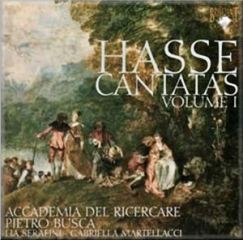Hasse - Cantatas, Vol.1 (2009)
Hasse - Cantatas, Vol.1 (2009)

1 Come l'ape di fiore in fiore: Aria for Soprano, Two Violins and Basso Continuo 4:27 Il nome, Cantata for Contralto, Flute and Basso Continuo 2 Aria. Scrivo in te l'amato nome 7:39 3 Recitativo. O pianta avventurosa 1:14 4 Aria. Per te di lieto aprile 5:28 Sonata a tre in E Minor, Op. 3 No. 2 for Two Flutes and Basso Continuo 5 I. Allegro moderato 3:43 6 II. — 2:55 7 III. Allegro 2:10 Chieggio ai gigli ed alle rose, Cantata for Soprano and Basso Continuo 8 Aria. Chieggio ai gigli ed alle rose 4:12 9 Recitativo. Ahi, tormento spietato 1:38 10 Aria. O pietoso zeffiretto 4:10 Sonata a tre in D Major, Op. 3 No. 3 for Two Flutes and Basso Continuo 11 I. Allegro moderato 2:51 12 II. Adagio 3:26 13 III. Allegro 2:26 È ver, mia fille, è vero, Cantata for Contralto, Two Violins, Viola and Basso Continuo 14 Recitativo. È ver, mia fille, è vero 1:16 15 Aria. Ne' sguardi miei languenti 5:21 16 Recitativo. Or ecco al fin disciolta 1:11 17 Aria. Sì, vezzosetti rai 4:57 - 18 Muta è l'imago dell'idolo amato: Aria for Soprano, Two Violins and Basso Continuo 4:48 Lia Serafini (soprano) Gabriella Martellacci (contralto) Accademia del Ricercare Pietro Busca (director)
It has been said of Johann Adolf Hasse that few composers have been as famous in their time as Hasse, and yet as quickly forgotten. In Italy he had been called the ‘Padre della musica’, yet upon his death only one musical work was written in his honour by J.A Hiller, a friend of Hasse. So what happened to one of the most successful opera composers of the 18th century after Handel and Gluck, to bring about such a fall from favour? A composer who knew Frederick the Great and performed with the monarch? First, he simply became out of date after a very long career, and secondly, he lost his considerable wealth due to the collapse of the Venetian financial system in the early 1780s. He died in Venice aged 84, his funeral attended by his daughter and a few others. His gravestone wasn’t erected until 1820 – a sad story indeed.
In his pomp Hasse was the epitome of a modern composer. Traveling widely, especially to Italy, he spoke only Italian (he was German by birth), set only Italian texts, and married one of the stars of Italian opera. Although he spent 30 years as Kapellmeister in Dresden, and a decade at the Imperial Court in Vienna, he never severed his ties with Italy.
The music on this disc, the first volume of a Brilliant Classics edition of Hasse, dates from early in his career and just predates his meteoric rise to fame. His style straddles the late Baroque of Alessandro Scarlatti and the emerging Classical style of Gluck, the young Joseph Haydn and the Stamitz brothers.
His music and reputation deserve reassessment. It was after all Mozart who wrote that he hoped to ‘become immortal, like Handel and Hasse’. ---prestoclassical.co.uk
Johann Adolf Hasse, although German-born, spent the bulk of his career in Italy, studied with the renowned Alessandro Scarlatti, spoke only Italian and composed vocal music exclusively in his adopted language, or in the case of sacred music, Latin. Although relegated to the sidelines in modern times, he was greatly respected in his day. Mozart held him in the same lofty company as Handel, and aspired to be himself remembered in the same league as Hasse.
Much of the vocal music presented on this elegant program has never been recorded before, and we have the Accademia del Ricercare to thank for bringing such engaging music back to life. Two fine soloists, soprano Lia Serafini and contralto Gabriella Martellacci alternate to present rich performances of arias and cantatas meant to entertain and impress guests in small intimate gatherings in the home. How lovely it is to hear a female contralto sing these lovely melodies instead of having to endure yet another failed baritone in the guise of a counter-tenor. Note to conductors: unless you can get a Mark Crayton or a David Daniels, use girls!
Hasse favored flutes as accompanying instruments but in keeping with common Baroque practice, any handy melodic instrument could be substituted, and we get superb playing from some outstanding Italian instrumentalists in both the wind and string sections. Of particular merit are the two dreamily charming trio sonatas from Op, 3, which are delivered with both serene airiness and sprightly rhythmic vitality.
Both vocal soloists deliver superb performances. Ms. Serafini’s light and radiant soprano is beautifully contrasted by Ms. Martellacci’s warm yet ever-clear contralto. Both ladies sing with distinct enunciation making the texts easy to understand. Both use ornamentation with ease, employing just enough to make things interesting without it getting in the way of the composer’s lilting melodies.
Kudos go to Brilliant Classics for joining Naxos and Arte Nova in bringing forth fascinating recordings at such a budget price. Program notes are informative and of just enough length to avoid being too academic or tiresome. Texts are provided, but sadly are presented only in the original language. If Brilliant can afford to translate the program note into three languages, why not the texts? ---Kevin Sutton, musicweb-international.com
download (mp3 @ kbs):








